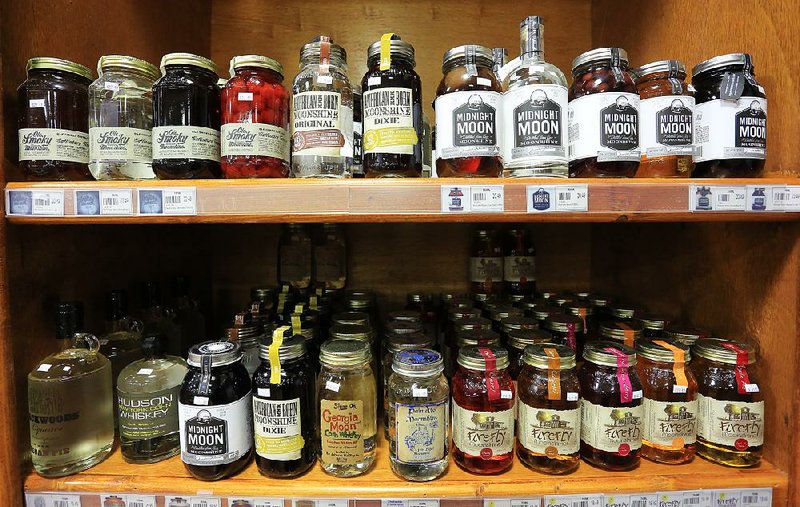Moonshine is old as the hills -- probably as old as the first liquor tax, and the first whiskeymaker who didn't want to pay it.
"Moonshine lore recedes into such a dim past," Esther Kellner writes in Moonshine: Its History and Folklore (Bobbs-Merrill, 1971). Home distilling is ancient and global. It only seems uniquely American, having filtered through "almost every facet of American life."
American Prohibition encouraged even more people to set up a still, some in swanky settings among the gentlemen of New York. But moonshining attached like a tick to the poor South, where people sometimes had no other way to eke a living.
The enduring picture of the moonshiner is a bushy-bearded hillbilly with a slouch hat and a jug. He made one of his first appearances in print in Harper's Weekly, 1877.
The illustration went with a story
titled, "The Moonshine Man: A Peep Into His Haunts and Hiding Places." The story placed him in Kentucky, but the moonshine man filled his jug in Arkansas, too.
Even as the law went after him and his moonshinin' kin, Arkansas played him up as a tourist attraction. Travelers sent home picture postcards that made it look like the state had as many moonshine stills as corncob pipes and lazy hounds -- and maybe so.
Down in the hollow, deep out of sight, the old moonshine man turned out a brand of white whiskey so compelling, people took a chance on going blind to drink it.
It was "genuine, double-rectified busthead," as Fort Smith Marshal Rooster Cogburn (John Wayne) describes his refreshment of choice in True Grit (1969), based on the novel by Arkansan Charles Portis.
The old still looked like a steampunk contraption, typically set up next to a stream for the water supply. The moonshiner built a fire under a tank full of sour mash, a mess of fermented cornmeal and water, sugar, yeast and sometimes mystery flavorings.
Evaporated alcohol rose off the not-quite-boiling mash. Around and about, the steam made its way through a copper coil, the worm. The steam cooled to liquid, and the moonshine came out in a dribbling stream.
One place to see an old-time still is the Carroll County Heritage Center Museum in Berryville. In fact, they have two kinds of stills on display, curator Randy High says -- the full-size busthead-maker that came from a raid years ago, and the other scaled down to sit on a stove.
"The sheriff drilled holes," making sure these two miscreants have squeezed their last corn, the curator says. State law calls for the destruction of "any illicit stills."
Visitors invariably pause for a look at the stills, and almost nobody asks what they're seeing.
"They know what it is," High says. "They've seen it on The Waltons."
MOONSHINE IN THE SUNSHINE
Today's moonshine comes to new light in ways such as these:
• "Sales of unaged corn whiskey increase triple digits" to about $9 million a year over the previous three years, according to an April 1 report in Beverage Industry. The trade journal reports a new market among customers of ages 21-35.
The millennial generation has taken to legal moonshine out of respect for their elders, it says, and as a way to show rebellion -- tax-paid, government-sanctioned, blueberry-flavored rebellion.
• Moonshiners. They "keep tradition alive and make a fortune in the process," according to the The Discovery Channel's description of this cable reality series.
• NASCAR. Some of early-day car racing's star drivers got their start as moonshine runners -- Ray Parks, for one. His team won NASCAR's first championship.
Author Neal Thompson tells the story in Driving With the Devil: Southern Moonshine, Detroit Wheels and the Birth of NASCAR (Crown, 2006).
Thompson credits NASCAR's creation to "a bunch of motherless, dirt-poor Southern teens, driving with the devil in jacked-up Fords full of corn whiskey."
• Recipes. The Internet pours out lists of ingredients that used to be secrets -- used to be kept as zip-lipped as the location of pappy's still.
How to Make Moonshine by George Jenkins, for example, is a Kindle e-book.
The electronic how-to book says the time has come to taste the art in a well-made batch of moonshine. Still, so to speak, "one thing continues as before -- it is unlawful."
Style on 07/27/2014
